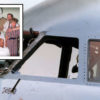On November 7, 2006, Chicago’s O’Hare International Airport became the focal point of an unusual occurrence. Twelve United Airlines staff members reported seeing a peculiar metallic, saucer-shaped object hovering in the sky. Captured on video, this unidentifiable object quickly garnered international attention when the Federal Aviation Administration (FAA) made the footage public.
In an attempt to provide clarity on the incident, the FAA presented an explanation based on a natural meteorological phenomenon. They identified the observed formation as a “hole-punched cloud” or “fallstreak hole.” Such holes appear in certain cloud formations, particularly cirrocumulus or altocumulus clouds, when planes introduce ice crystals, causing supercooled water droplets in the clouds to freeze and fall, leaving behind a gap.
The “fallstreak hole” explanation, while scientifically grounded, wasn’t universally accepted. Applied Physics, a privately-funded research group, comprising 30 Ph.D. physicists, delved deeper into the incident. Their research led them to consider the UFO sighting as a potential indication of a sophisticated theoretical propulsion system, specifically the ‘Alcubierre warp drive.’
The Alcubierre warp drive, a concept originating from theoretical physicist Miguel Alcubierre in 1994, proposes an innovative method of interstellar travel. This system suggests moving between stars by manipulating the fabric of time and space around a craft. This idea of bending space-time isn’t just a staple of science fiction but has roots in legitimate theoretical physics.
In 2021, Alexey Bobrick, Applied Physics’ chief science officer, disclosed his findings on the Alcubierre drive in the journal Classical and Quantum Gravity. He highlighted that specific models of warp drive spacetimes indicate the potential benefits of spacecrafts adopting certain shapes. According to his research, the bending of spacetime could be more efficient with particular geometries, such as a saucer or spherical shape, in alignment with the principles of general relativity.
Supporting Bobrick’s findings, physicist Brandon Melcher from the same team elaborated on the witness accounts from the O’Hare incident. The testimonials pointed towards a metallic object, roughly 50 feet in diameter, positioned approximately 1,500 feet above an international airport passenger gate. Strikingly, this object exhibited remarkable acceleration, moving from a stationary position to speeds ranging between 1,000 to 2,000 feet per second in a near-instant.
Historically, no known aircraft has displayed such acceleration capabilities. Drawing parallels, a similar unexplained phenomenon occurred in 2021 over California, another region with reported UFO sightings. This event, also characterized as a “wormhole” or “fallstreak,” was noteworthy since FAA records indicated no aircraft activity in the vicinity when the formation appeared.
While explanations and theories about this event are plentiful, definitive conclusions remain elusive.
Various scientific interpretations have been proposed, from meteorological phenomena to advanced propulsion systems. However, despite the passage of nearly two decades, the event stands as one of the prominent unsolved aerial mysteries, prompting continued examination and discourse among experts and observers alike.
































